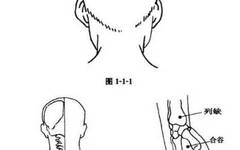Common cold is a febrile disease caused by external wind pathogens or seasonal viruses, referred to in modern medicine as respiratory infectious diseases. Clinical manifestations include fever, chills, headache, nasal congestion, runny nose, sneezing, cough, sore throat, and floating pulse. Colds can occur in all seasons, with a higher incidence in the cold winter and spring seasons, making it a common clinical ailment. According to the WeChat public account on meridian techniques, due to the different external pathogenic factors, colds can be classified into wind-cold, wind-heat, and summer-damp types.
Wind-Cold Cold
(1) Symptoms Severe chills, mild fever, headache without sweating, clear nasal discharge, thin white phlegm, no thirst, pale red tongue, thin white coating, floating tight pulse. (2) Treatment Method 1 (1) Selected Points: Baihui (Hundred Meetings), Dazhui (Great Vertebra), Fengmen (Wind Gate), Feiyu (Lung Shu) (2) Location Baihui: At the top of the head, on the midline, at the midpoint of the line connecting the tips of the ears, or 5 cun directly above the anterior hairline. Dazhui: On the back, on the midline, in the depression below the spinous process of the seventh cervical vertebra (the most prominent bone when the head is lowered). Fengmen: On the back, below the spinous process of the second thoracic vertebra, 1.5 cun lateral to the midline. Feiyu: On the back, below the spinous process of the third thoracic vertebra, 1.5 cun lateral to the midline. (3) Moxibustion: Use moxa sticks for gentle moxibustion, 15-20 minutes per point, until the local skin becomes warm and red, and the chills are relieved, once or twice daily, stopping when the illness is resolved.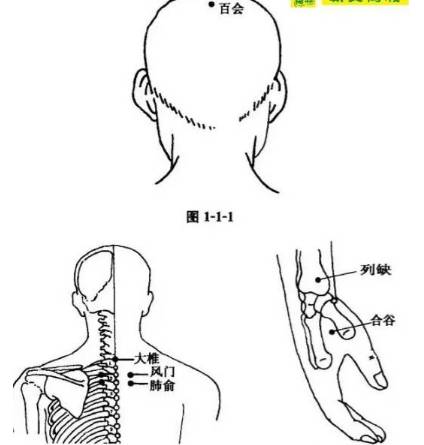 2. Method 2 (1) Selected Points: Dazhui, Hegu (Union Valley), Feiyu, Lieque (Palace of the Abode) (2) Location Dazhui: On the midline of the back, in the depression below the spinous process of the seventh cervical vertebra. Hegu: Commonly known as the tiger’s mouth, at the muscle bulge when the thumb is brought together. Feiyu: On the back, below the spinous process of the third thoracic vertebra, 1.5 cun lateral to the midline. Lieque: Cross the hands naturally at the tiger’s mouth, pressing the index finger of one hand on the radial styloid of the other hand, in the depression below the fingertip. (3) Moxibustion: Use moxa sticks for gentle moxibustion, 15 minutes per point, until the local skin becomes warm and red, and the chills are relieved, once or twice daily, stopping when the illness is resolved.
2. Method 2 (1) Selected Points: Dazhui, Hegu (Union Valley), Feiyu, Lieque (Palace of the Abode) (2) Location Dazhui: On the midline of the back, in the depression below the spinous process of the seventh cervical vertebra. Hegu: Commonly known as the tiger’s mouth, at the muscle bulge when the thumb is brought together. Feiyu: On the back, below the spinous process of the third thoracic vertebra, 1.5 cun lateral to the midline. Lieque: Cross the hands naturally at the tiger’s mouth, pressing the index finger of one hand on the radial styloid of the other hand, in the depression below the fingertip. (3) Moxibustion: Use moxa sticks for gentle moxibustion, 15 minutes per point, until the local skin becomes warm and red, and the chills are relieved, once or twice daily, stopping when the illness is resolved.
Wind-Heat Cold
(1) Symptoms Mild chills, severe fever, headache with sweating, thick nasal discharge, yellow and thick phlegm, thirst, red tongue, thin yellow coating, floating rapid pulse. (2) Treatment Method 1 (1) Selected Points: Dazhui, Quchi (Pool at the Bend), Chize (Cubital Marsh), Hegu (Union Valley)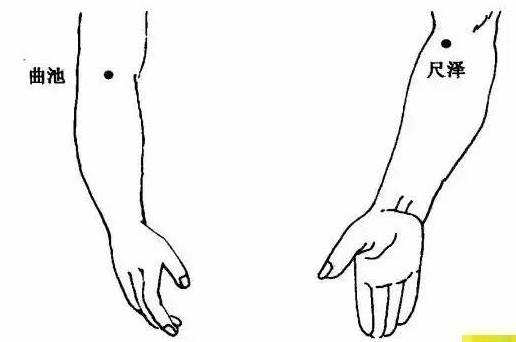 (2) Location Dazhui: On the midline of the back, in the depression below the spinous process of the seventh cervical vertebra. Quchi: Bend the elbow, in the depression at the radial side of the elbow crease. Chize: In the elbow crease, at the radial side of the biceps tendon. Hegu: Commonly known as the tiger’s mouth, at the muscle bulge when the thumb is brought together. (3) Moxibustion: Use moxa sticks for sparrow pecking moxibustion, 10-15 minutes per point, once or twice daily, stopping after 1-2 additional treatments once symptoms disappear. 2. Method 2 (1) Selected Points: Taiyang (Sun), Yintang (Hall of Impression), Quchi, Hegu (Union Valley)
(2) Location Dazhui: On the midline of the back, in the depression below the spinous process of the seventh cervical vertebra. Quchi: Bend the elbow, in the depression at the radial side of the elbow crease. Chize: In the elbow crease, at the radial side of the biceps tendon. Hegu: Commonly known as the tiger’s mouth, at the muscle bulge when the thumb is brought together. (3) Moxibustion: Use moxa sticks for sparrow pecking moxibustion, 10-15 minutes per point, once or twice daily, stopping after 1-2 additional treatments once symptoms disappear. 2. Method 2 (1) Selected Points: Taiyang (Sun), Yintang (Hall of Impression), Quchi, Hegu (Union Valley)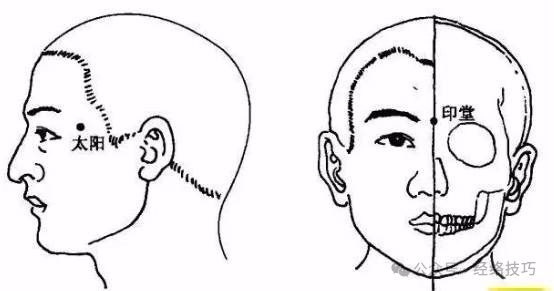 (2) Location Taiyang: In the depression about 1 cun behind the outer canthus of the eye. Yintang: At the midpoint of the line connecting the two eyebrows. Quchi: Bend the elbow, in the depression at the outer end of the elbow crease (on the thumb side). Hegu: Commonly known as the tiger’s mouth, at the muscle bulge when the thumb is brought together. (3) Moxibustion: Use moxa sticks for sparrow pecking moxibustion, 10-15 minutes per point, once daily, stopping after 1-2 additional treatments once symptoms disappear.
(2) Location Taiyang: In the depression about 1 cun behind the outer canthus of the eye. Yintang: At the midpoint of the line connecting the two eyebrows. Quchi: Bend the elbow, in the depression at the outer end of the elbow crease (on the thumb side). Hegu: Commonly known as the tiger’s mouth, at the muscle bulge when the thumb is brought together. (3) Moxibustion: Use moxa sticks for sparrow pecking moxibustion, 10-15 minutes per point, once daily, stopping after 1-2 additional treatments once symptoms disappear.
Summer-Damp Cold
(1) Symptoms Common in summer, when exposed to the seasonal heat pathogen, with both heat and dampness present, symptoms include fever, sweating without relief, nasal congestion with thick discharge, dizziness, headache, heaviness in the body, irritability, thirst, chest tightness with nausea, short and red urine, red tongue, yellow greasy coating, and slippery rapid pulse. (2) Treatment Method 1 (1) Selected Points: Feiyu, Zhiyang (Reaching Yang), Yinlingquan (Yin Mound Spring), Zusanli (Leg Three Miles) (2) Location Feiyu: Below the spinous process of the third thoracic vertebra, 1.5 cun lateral to the midline. Zhiyang: On the midline of the back, in the depression below the spinous process of the seventh thoracic vertebra. Yinlingquan: Below the medial condyle of the tibia. Zusanli: 3 cun below the knee, 1 finger breadth lateral to the anterior border of the tibia. (3) Moxibustion: Use moxa sticks for gentle moxibustion, 15 minutes per point, until the local area is warm and red, once daily, and after symptoms of dizziness, headache, and chest tightness disappear, add 1-2 more treatments.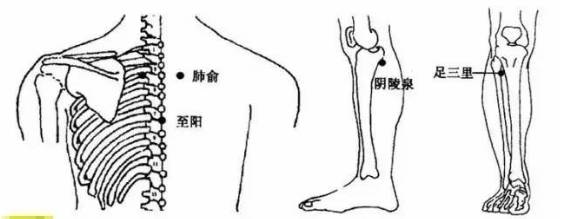 2. Method 2 (1) Selected Points: Feiyu, Xinyu (Heart Shu), Ge Shu (Diaphragm Shu), Tiantu (Heavenly Prominence), Shanzhong (Middle of the Chest), Shenque (Spirit Gate) (2) Location Feiyu: Below the spinous process of the third thoracic vertebra, 1.5 cun lateral to the midline. Xinyu: Below the spinous process of the fifth thoracic vertebra, 1.5 cun lateral to the midline. Ge Shu: Below the spinous process of the seventh thoracic vertebra, 1.5 cun lateral to the midline. Tiantu: At the center of the suprasternal notch. Shanzhong: On the midline, at the level of the fourth intercostal space, at the midpoint of the line connecting the two nipples. Shenque: Commonly known as the navel. (3) Moxibustion: Use ginger slices for moxibustion, cut ginger into 2 mm thick slices, then make 10 or more evenly distributed small holes in the ginger slice, place a moxa cone the size of a yellow bean on top, light the moxa cone, and when it is about to burn out and the skin feels hot, remove it, 5-7 cones per point, once or twice daily, stopping when the cold is cured.
2. Method 2 (1) Selected Points: Feiyu, Xinyu (Heart Shu), Ge Shu (Diaphragm Shu), Tiantu (Heavenly Prominence), Shanzhong (Middle of the Chest), Shenque (Spirit Gate) (2) Location Feiyu: Below the spinous process of the third thoracic vertebra, 1.5 cun lateral to the midline. Xinyu: Below the spinous process of the fifth thoracic vertebra, 1.5 cun lateral to the midline. Ge Shu: Below the spinous process of the seventh thoracic vertebra, 1.5 cun lateral to the midline. Tiantu: At the center of the suprasternal notch. Shanzhong: On the midline, at the level of the fourth intercostal space, at the midpoint of the line connecting the two nipples. Shenque: Commonly known as the navel. (3) Moxibustion: Use ginger slices for moxibustion, cut ginger into 2 mm thick slices, then make 10 or more evenly distributed small holes in the ginger slice, place a moxa cone the size of a yellow bean on top, light the moxa cone, and when it is about to burn out and the skin feels hot, remove it, 5-7 cones per point, once or twice daily, stopping when the cold is cured.
4. Symptomatic Treatment
Colds are often accompanied by symptoms such as neck pain, abdominal distension with loose stools, cough with sore throat, headache, and nasal congestion. Clinically, additional methods can be used based on accompanying symptoms. (1) Neck Pain (1) Selected Point: Fengchi (Wind Pool)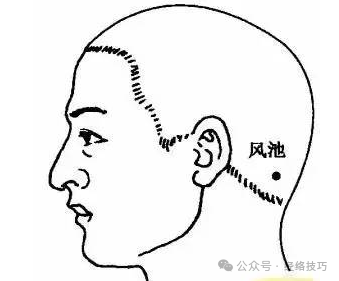 (2) Location Fengchi: At the nape, in the depression between the sternocleidomastoid and trapezius muscles, below the occipital bone. (3) Moxibustion: Use moxa sticks for gentle moxibustion, 15 minutes per point, once daily, stopping when neck pain disappears. (2) Abdominal Distension with Loose Stools (1) Selected Point: Tianshu (Heavenly Pivot) (2) Location Tianshu: 2 cun lateral to the midline at the level of the umbilicus. (3) Moxibustion: Use moxa sticks for gentle moxibustion, 15 minutes per point, once daily, adding 1-2 more treatments after normal bowel movements. (3) Cough with Sore Throat (1) Selected Point: Shaoshang (Lesser Shang) (2) Location Shaoshang: On the radial side of the thumb tip, 0.1 cun from the corner of the nail.
(2) Location Fengchi: At the nape, in the depression between the sternocleidomastoid and trapezius muscles, below the occipital bone. (3) Moxibustion: Use moxa sticks for gentle moxibustion, 15 minutes per point, once daily, stopping when neck pain disappears. (2) Abdominal Distension with Loose Stools (1) Selected Point: Tianshu (Heavenly Pivot) (2) Location Tianshu: 2 cun lateral to the midline at the level of the umbilicus. (3) Moxibustion: Use moxa sticks for gentle moxibustion, 15 minutes per point, once daily, adding 1-2 more treatments after normal bowel movements. (3) Cough with Sore Throat (1) Selected Point: Shaoshang (Lesser Shang) (2) Location Shaoshang: On the radial side of the thumb tip, 0.1 cun from the corner of the nail.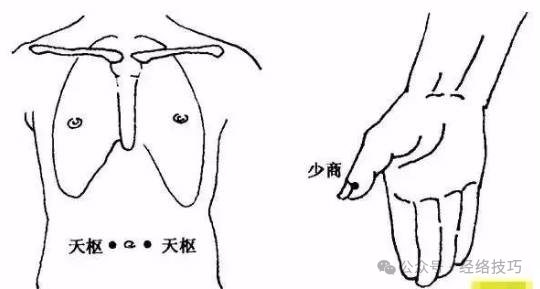 (3) Moxibustion: Use moxa sticks for gentle moxibustion, 15 minutes per point, once daily, stopping when symptoms disappear. (4) Headache and Nasal Congestion (1) Selected Points: Taiyang, Yintang (2) Location Taiyang: In the depression about 1 cun behind the outer canthus of the eye. Yintang: At the midpoint of the line connecting the two eyebrows. (3) Moxibustion: Use moxa sticks for gentle moxibustion, 15 minutes per point, once daily, stopping when symptoms disappear.
(3) Moxibustion: Use moxa sticks for gentle moxibustion, 15 minutes per point, once daily, stopping when symptoms disappear. (4) Headache and Nasal Congestion (1) Selected Points: Taiyang, Yintang (2) Location Taiyang: In the depression about 1 cun behind the outer canthus of the eye. Yintang: At the midpoint of the line connecting the two eyebrows. (3) Moxibustion: Use moxa sticks for gentle moxibustion, 15 minutes per point, once daily, stopping when symptoms disappear.
Precautions
1. During moxibustion, avoid wind and keep warm to prevent chills.2. During the winter and spring epidemic seasons, take preventive measures, regularly engage in outdoor cold-resistant exercises to enhance disease resistance; frequently open doors and windows to maintain indoor air circulation.3. Regular participation in physical exercise to enhance physical fitness can reduce the occurrence of this disease. Regular moxibustion at Zusanli can enhance the body’s resistance. Once or twice a week for 4 weeks, and continuous moxibustion for 1 week during the peak flu season can have a preventive effect for those prone to colds.⊙ Note:Content sourced from the internet, this platform does not bear any responsibility for any resulting issues!If you have any questions, please click the bottom[Leave a Message]to leave a message. Let’s promote health together

